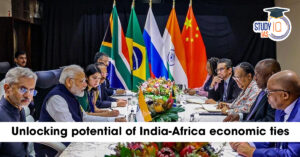Table of Contents
Context: A report by the Global Trade Research Initiative (GTRI) India’s imports from China rose to $101 billion while exports stagnated.
Findings of the Report

- Crossed $101 billion in 2023-24, up from $70 billion in 2018-19 (44% increase).
- Over 15 years, China’s share of India’s industrial goods imports rose from 21% to 30%.
- China is a dominant supplier in various sectors:
- Top supplier in 8 major industrial sectors, such as:
- 42% of India’s textile and clothing imports.
- 40% of machinery imports.
- 4% of electronics, telecom, and electrical products.
- 2% of chemicals and pharmaceuticals.
- Accounts for 30% of India’s industrial goods imports (up from 21% in 15 years).
- Over 70% import share for some products (e.g., textiles, machinery).
- Goods like organic chemicals, Active Pharmaceutical Ingredients (APIs), and plastics, which make up 37% of imports, indicate a need for upgrading these industries.
- Top supplier in 8 major industrial sectors, such as:
- Trade Deficit:
- India’s exports to China stagnated around $16 billion annually between 2018-19 and 2023-24.
- This resulted in a cumulative trade deficit exceeding $387 billion over six years.
- Strategic Implications:
- The report by the Global Trade Research Initiative (GTRI) highlights the strategic concerns of this dependence on China.
- It emphasises the need to:
- Mitigate economic risks.
- Bolster domestic industries.
- Reduce reliance on a geopolitical competitor.
- Reasons for the Increase:
- Influx of Chinese firms in the Indian market is expected to further increase imports.
- These Chinese firms are likely to source materials from their parent companies in China.
- Historical Context:
- India used to enjoy a trade surplus with China between 2003 and 2005.
- The situation reversed after 2005, with Chinese imports steadily increasing.
Causes of India-China Trade Deficit
The India-China trade deficit, which has been a persistent concern for Indian policymakers and economists, can be attributed to several factors:
- Structural Differences: China and India have significant differences in their industrial structures. China is known as the “world’s factory” due to its vast manufacturing capabilities, while India has a more diverse economy with strengths in services and agriculture. This structural disparity leads to a situation where India imports a wide range of manufactured goods from China while exporting fewer products in return.
- Competitive Advantage of Chinese Goods: Chinese goods often enjoy a competitive advantage in terms of cost, quality, and variety. This advantage stems from China’s efficient manufacturing processes, economies of scale, government subsidies, and lower labor costs. As a result, Indian consumers and industries prefer Chinese goods in many sectors, leading to a surge in imports.
- Trade Barriers in China: Despite India’s efforts to increase its exports to China, Indian goods face various trade barriers in the Chinese market, including non-tariff barriers, regulatory hurdles, and discriminatory practices. These barriers limit the access of Indian products to the Chinese market, exacerbating the trade deficit.
- Complementary Trade Patterns: India and China often engage in complementary trade patterns, where India imports finished goods and intermediate products from China for its industries, while exporting raw materials and commodities to China. This asymmetry in trade patterns contributes to the trade deficit.
- Currency Dynamics: Currency fluctuations can also influence the trade deficit between India and China. The depreciation of the Indian rupee against the Chinese yuan can make Chinese goods relatively cheaper for Indian buyers, further stimulating imports and widening the trade gap.
- Infrastructure and Logistics Challenges: India faces infrastructure and logistical challenges that affect its export competitiveness. Inefficient transportation networks, inadequate port facilities, and bureaucratic red tape can increase the cost and time of exporting goods, hindering India’s ability to narrow the trade deficit with China.
- Strategic Imports: Some imports from China are strategic in nature, such as electronic components, machinery, and pharmaceutical ingredients, which are crucial for India’s industries and infrastructure development. Dependency on Chinese imports for these strategic goods adds to the trade deficit.
Addressing the India-China trade deficit requires a multifaceted approach, including measures to enhance India’s manufacturing competitiveness, reduce trade barriers, improve infrastructure, promote exports diversification, and foster closer economic cooperation between the two countries. Efforts to rebalance the trade relationship and create a more level playing field will be essential in narrowing the trade gap over the long term.


 Unlocking the Potential of India–Afric...
Unlocking the Potential of India–Afric...
 Speedy Justice and the Crisis in Consume...
Speedy Justice and the Crisis in Consume...
 Kavachi Volcano: Location, Features, Eru...
Kavachi Volcano: Location, Features, Eru...

























